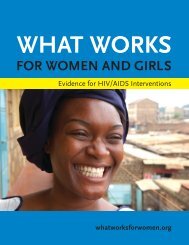Global Tuberculosis Report -- 2012.pdf
Global Tuberculosis Report -- 2012.pdf
Global Tuberculosis Report -- 2012.pdf
You also want an ePaper? Increase the reach of your titles
YUMPU automatically turns print PDFs into web optimized ePapers that Google loves.
new TB vaccine candidate. A Phase IIb trial of MVA85A isnow being conducted in adults living with HIV in Senegaland South Africa; the trial started in 2011 and up to 1400participants will be enrolled.AERAS-402/Crucell Ad35 is an adeno-vectored vaccinecandidate designed as a booster vaccine for infants,adolescents and adults. A Phase IIb multicentre clinicaltrial in healthy infants is under way in Kenya, Mozambiqueand South Africa; up to 4000 participants will beenrolled.There are four vaccines in Phase II trials. M72 andHybrid-1 are two distinct protein subunit vaccines, formulatedin novel adjuvants to enhance their immunogenicity.Both vaccines, which are based on a combinationof two immune-dominant antigens from M. tuberculosis,are being tested in Phase IIa trials in Europe and Africa.VPM 1002 is a live recombinant vaccine, derived from thePrague strain of the BCG vaccine into which the listerolysingene from Listeria monocytogenes has been clonedand the urease gene deleted to improve immunogenicity.This vaccine is currently in a Phase IIa trial in South Africa.Finally, RUTI, a non-live vaccine based on fragmentedM. tuberculosis bacteria, is in a Phase IIa trial in Spain.Research on new TB vaccines is at a crucial juncture.While the past decade focused on the discovery of novelapproaches and moving new vaccine candidates from thelaboratory to early clinical trials, the next decade willfocus on consolidating progress. 1 This will entail learningfrom the efficacy of vaccine candidates in clinical developmentand identifying much-needed markers and correlatesof immune protection that will greatly assist in theselection of the next generation of vaccine candidates. 2The future course of work on new TB vaccines has beencharted in a new strategic document, <strong>Tuberculosis</strong> vaccines:a strategic blueprint, developed by the Stop TB Partnership’sWorking Group on New TB Vaccines and publishedin March 2012 (Box 8.4).8.4 Fundamental science and operationalresearch to stimulate innovation andoptimize the use of available toolsFundamental science is necessary to drive innovations innew tools for improved TB care and control. Fundamentalresearch is required to better characterize M. tuberculosisand to improve understanding of the interaction betweenthe bacillus and the human host, as a basis for maintainingthe flow of new technologies into the productpipeline. Investments in basic science for TB worldwide,at US$ 129 million in 2010, represented 20% of globalspending on TB research and development. The largestshare of this funding (43%) was from NIH/NIAID.Researchers supported to conduct biomedical andfundamental research on TB through NIAID and othermajor funding agencies are making great strides in redefiningthe spectrum of TB disease and the transition fromlatent to active TB, and developing a better understandingof the reasons why prolonged antibiotic treatment isneeded. This progress is expected to deliver better knowledgeabout pathogenesis, identification of biomarkers andbio-signatures relevant to new TB diagnostics. It is alsoexpected to point to new targets for anti-TB drugs as wellas early indicators of protective immunity, vaccine efficacyand early response to treatment. Such developmentswill facilitate the selection and testing of new interventions.To catalyze further progress and pave the way forfuture research, an International Roadmap for TB Researchhas been developed. 3 This outlines critical priority areasfor future scientific investment.A guide on Operational research priorities to improve TBcare and control was published in 2011. 4 It defines thecritical questions that need to be addressed to improvecurrent programmatic performance and to facilitate theintroduction of novel strategies and interventions thatuse new tools.1Ottenhoff THM, Kaufmann SHE. Vaccines against tuberculosis:where are we and where do we need to go? PLoS Pathogens,2012, 8(5):e1002607 (doi:10.1371/journal.ppat.1002607).2Barker LF et al. <strong>Tuberculosis</strong> vaccine research: the impact ofimmunology. Current Opinion in Immunology, 2009, 21(3):331–338.3Stop TB Partnership and World Health Organization. AnInternational Roadmap for <strong>Tuberculosis</strong> Research. Geneva: WorldHealth Organization, 2011 (also available at:www.stoptb.org/assets/documents/resources/publications/technical/tbresearchroadmap.pdf;accessed July, 2012).4Stop TB Partnership, <strong>Global</strong> Fund to Fight AIDS, <strong>Tuberculosis</strong>and Malaria. Priorities in operational research to improvetuberculosis care and control. Geneva, World Health Organization,2011 (also available at:http://whqlibdoc.who.int/publications/2011/9789241548250_eng.pdf; accessed July 2012).GLOBAL TUBERCULOSIS REPORT 2012 89
















